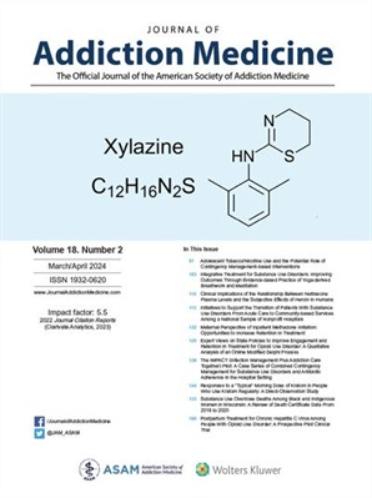Maternal Perception of Infant Sleep and Bonding in Opioid Use Disorder.
IF 4.2
3区 医学
Q1 SUBSTANCE ABUSE
引用次数: 0
Abstract
OBJECTIVE Infant sleep problems are common in early infancy and can negatively influence maternal-infant bonding. As opioid-exposed neonates are at increased risk of sleep difficulties, we examined the association between maternal perception of infant sleep difficulties and maternal-infant bonding among dyads affected by maternal opioid use disorder (OUD), from birth through 6 months. METHODS We enrolled 100 birthing people (participants) between 6 months and 2 years postpartum who had received medications for OUD during their pregnancy. Participants answered questions regarding maternal and infant characteristics, as well as the Postpartum Bonding Questionnaire (PBQ), on which higher scores indicate decreased maternal-infant bonding. Unadjusted and adjusted linear regression models were used to examine the association between infant sleep and bonding. RESULTS Of 100 study participants, 91 completed the PBQ. Of these, 55% reported difficulties with their infant's sleep during the first 6 months postpartum. Although bonding scores were overall strong, those who reported infant sleep difficulties scored on average 10.40 points higher on the PBQ (β = 10.40; 95% confidence interval, 5.94-14.85) than participants who did not report sleep difficulties, indicating the negative association between infant sleep problems and bonding. This effect remained after adjusting for relevant maternal-infant characteristics (β = 6.86; 95% confidence interval, 2.49-11.24). CONCLUSIONS In this study among postpartum individuals with OUD, maternal perception of infant sleep problems was associated with reduced maternal-infant bonding. This relationship between infant sleep and bonding offers a target for supporting dyads affected by OUD.阿片类药物使用失调症中母亲对婴儿睡眠和亲情的感知。
目的婴儿睡眠问题在婴儿早期很常见,会对母婴关系产生负面影响。由于暴露于阿片类药物的新生儿出现睡眠困难的风险增加,我们研究了受母亲阿片类药物使用障碍(OUD)影响的二人组中,从出生到 6 个月期间,母亲对婴儿睡眠困难的感知与母婴关系之间的关联。参与者回答了有关母婴特征以及产后亲子关系问卷(PBQ)的问题,PBQ 分数越高表明母婴亲子关系越差。我们使用未调整和调整后的线性回归模型来研究婴儿睡眠与亲子关系之间的关联。其中 55% 的人表示在产后 6 个月内婴儿睡眠有问题。虽然亲子关系得分总体较高,但与未报告睡眠困难的参与者相比,报告婴儿睡眠困难的参与者在 PBQ 上的得分平均高出 10.40 分(β = 10.40;95% 置信区间,5.94-14.85),这表明婴儿睡眠问题与亲子关系之间存在负相关。在对相关母婴特征进行调整后,这一影响依然存在(β = 6.86;95% 置信区间,2.49-11.24)。婴儿睡眠与亲情之间的这种关系为支持受 OUD 影响的夫妇提供了目标。
本文章由计算机程序翻译,如有差异,请以英文原文为准。
求助全文
约1分钟内获得全文
求助全文
来源期刊

Journal of Addiction Medicine
医学-药物滥用
CiteScore
6.10
自引率
9.10%
发文量
260
审稿时长
>12 weeks
期刊介绍:
The mission of Journal of Addiction Medicine, the official peer-reviewed journal of the American Society of Addiction Medicine, is to promote excellence in the practice of addiction medicine and in clinical research as well as to support Addiction Medicine as a mainstream medical sub-specialty.
Under the guidance of an esteemed Editorial Board, peer-reviewed articles published in the Journal focus on developments in addiction medicine as well as on treatment innovations and ethical, economic, forensic, and social topics including:
•addiction and substance use in pregnancy
•adolescent addiction and at-risk use
•the drug-exposed neonate
•pharmacology
•all psychoactive substances relevant to addiction, including alcohol, nicotine, caffeine, marijuana, opioids, stimulants and other prescription and illicit substances
•diagnosis
•neuroimaging techniques
•treatment of special populations
•treatment, early intervention and prevention of alcohol and drug use disorders
•methodological issues in addiction research
•pain and addiction, prescription drug use disorder
•co-occurring addiction, medical and psychiatric disorders
•pathological gambling disorder, sexual and other behavioral addictions
•pathophysiology of addiction
•behavioral and pharmacological treatments
•issues in graduate medical education
•recovery
•health services delivery
•ethical, legal and liability issues in addiction medicine practice
•drug testing
•self- and mutual-help.
 求助内容:
求助内容: 应助结果提醒方式:
应助结果提醒方式:


